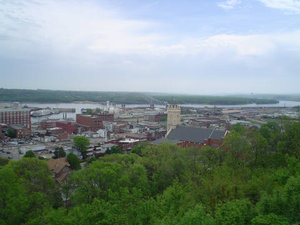Julien Dubuque Bridge
|
|
The Julien Dubuque Bridge traverses the Mississippi River. It joins the city of Dubuque, Iowa, and East Dubuque, Illinois. The bridge is part of the U.S. Highway 20 route. It is one of two automobile bridges over the Mississippi in the area, the Dubuque-Wisconsin Bridge three miles north links Dubuque with Wisconsin. The bridge is registered as a National Historic Landmark.
History
For a number of years, people living in the area wanted a bridge to replace the old bridge, which was called either the "High Bridge" or the "Wagon Bridge." However, economic conditions at the time made it difficult to get the financing together to build a new bridge.
During World War II, the importance of a new bridge became even more important as it would help facilitate military transportation. In 1942, the first parts of the bridge were begun. In 1943, the bridge was completed. It was painted grey to help camouflage the bridge in case of enemy attack.
Because the bridge was financed with bonds, it was initially operated as a toll bridge. Proceeds were used to help pay off the bonds. In the post war years, traffic was so heavy, that the bonds were paid off 11 years early, and the bridge became toll-free in 1954.
In the early 1990's, the bridge underwent an extensive renovation. The deck was completely replaced, and a new walkway was installed on the bridge. For many years, the bridge was a dark green color, however in more recent times it has again been painted a light grey color.
The Future of the Bridge
Over the years, there has been considerable debate about the future of the bridge. Much of this debate centers on having a four-lane connection with Illinois. The debate has produced several options,
- Expand the existing bridge to support four lanes.
- Build a second two lane bridge next to the existing bridge, and have traffic one way on each bridge.
- Build a new four lane bridge south of the Julien Dubuque Bridge, and leave the current bridge intact as an attraction or as a bridge for local traffic.
- Tear down the Julien Dubuque Bridge, and replace it with a four lane bridge that looks similar to the current bridge.
Most officials have indicated that they would rather not do anything that detracts from the historically important bridge. Discussion about expansion of the bridge continues, however no firm plans have yet been made about the future of the bridge.

